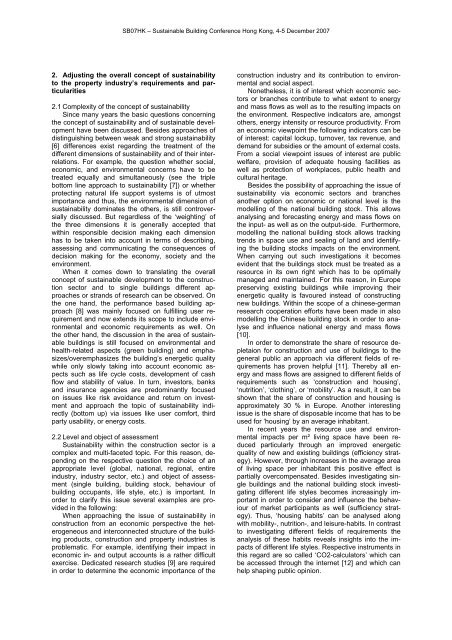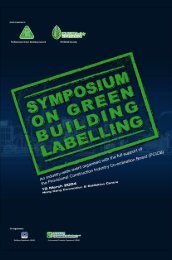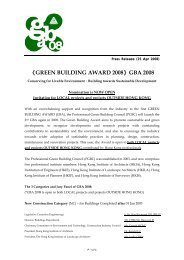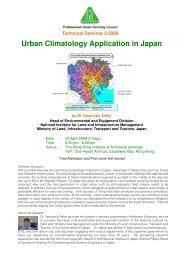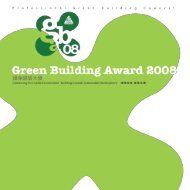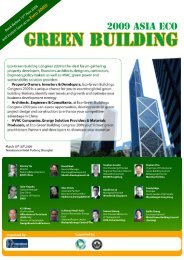Paper - The Professional Green Building Council
Paper - The Professional Green Building Council
Paper - The Professional Green Building Council
Create successful ePaper yourself
Turn your PDF publications into a flip-book with our unique Google optimized e-Paper software.
SB07HK – Sustainable <strong>Building</strong> Conference Hong Kong, 4-5 December 2007<br />
2. Adjusting the overall concept of sustainability<br />
to the property industry’s requirements and particularities<br />
2.1 Complexity of the concept of sustainability<br />
Since many years the basic questions concerning<br />
the concept of sustainability and of sustainable development<br />
have been discussed. Besides approaches of<br />
distinguishing between weak and strong sustainability<br />
[6] differences exist regarding the treatment of the<br />
different dimensions of sustainability and of their interrelations.<br />
For example, the question whether social,<br />
economic, and environmental concerns have to be<br />
treated equally and simultaneously (see the triple<br />
bottom line approach to sustainability [7]) or whether<br />
protecting natural life support systems is of utmost<br />
importance and thus, the environmental dimension of<br />
sustainability dominates the others, is still controversially<br />
discussed. But regardless of the ‘weighting’ of<br />
the three dimensions it is generally accepted that<br />
within responsible decision making each dimension<br />
has to be taken into account in terms of describing,<br />
assessing and communicating the consequences of<br />
decision making for the economy, society and the<br />
environment.<br />
When it comes down to translating the overall<br />
concept of sustainable development to the construction<br />
sector and to single buildings different approaches<br />
or strands of research can be observed. On<br />
the one hand, the performance based building approach<br />
[8] was mainly focused on fulfilling user requirement<br />
and now extends its scope to include environmental<br />
and economic requirements as well. On<br />
the other hand, the discussion in the area of sustainable<br />
buildings is still focused on environmental and<br />
health-related aspects (green building) and emphasizes/overemphasizes<br />
the building’s energetic quality<br />
while only slowly taking into account economic aspects<br />
such as life cycle costs, development of cash<br />
flow and stability of value. In turn, investors, banks<br />
and insurance agencies are predominantly focused<br />
on issues like risk avoidance and return on investment<br />
and approach the topic of sustainability indirectly<br />
(bottom up) via issues like user comfort, third<br />
party usability, or energy costs.<br />
2.2 Level and object of assessment<br />
Sustainability within the construction sector is a<br />
complex and multi-faceted topic. For this reason, depending<br />
on the respective question the choice of an<br />
appropriate level (global, national, regional, entire<br />
industry, industry sector, etc.) and object of assessment<br />
(single building, building stock, behaviour of<br />
building occupants, life style, etc.) is important. In<br />
order to clarify this issue several examples are provided<br />
in the following:<br />
When approaching the issue of sustainability in<br />
construction from an economic perspective the heterogeneous<br />
and interconnected structure of the building<br />
products, construction and property industries is<br />
problematic. For example, identifying their impact in<br />
economic in- and output accounts is a rather difficult<br />
exercise. Dedicated research studies [9] are required<br />
in order to determine the economic importance of the<br />
construction industry and its contribution to environmental<br />
and social aspect.<br />
Nonetheless, it is of interest which economic sectors<br />
or branches contribute to what extent to energy<br />
and mass flows as well as to the resulting impacts on<br />
the environment. Respective indicators are, amongst<br />
others, energy intensity or resource productivity. From<br />
an economic viewpoint the following indicators can be<br />
of interest: capital lockup, turnover, tax revenue, and<br />
demand for subsidies or the amount of external costs.<br />
From a social viewpoint issues of interest are public<br />
welfare, provision of adequate housing facilities as<br />
well as protection of workplaces, public health and<br />
cultural heritage.<br />
Besides the possibility of approaching the issue of<br />
sustainability via economic sectors and branches<br />
another option on economic or national level is the<br />
modelling of the national building stock. This allows<br />
analysing and forecasting energy and mass flows on<br />
the input- as well as on the output-side. Furthermore,<br />
modelling the national building stock allows tracking<br />
trends in space use and sealing of land and identifying<br />
the building stocks impacts on the environment.<br />
When carrying out such investigations it becomes<br />
evident that the buildings stock must be treated as a<br />
resource in its own right which has to be optimally<br />
managed and maintained. For this reason, in Europe<br />
preserving existing buildings while improving their<br />
energetic quality is favoured instead of constructing<br />
new buildings. Within the scope of a chinese-german<br />
research cooperation efforts have been made in also<br />
modelling the Chinese building stock in order to analyse<br />
and influence national energy and mass flows<br />
[10].<br />
In order to demonstrate the share of resource depletaion<br />
for construction and use of buildings to the<br />
general public an approach via different fields of requirements<br />
has proven helpful [11]. <strong>The</strong>reby all energy<br />
and mass flows are assigned to different fields of<br />
requirements such as ‘construction and housing’,<br />
‘nutrition’, ‘clothing’, or ‘mobility’. As a result, it can be<br />
shown that the share of construction and housing is<br />
approximately 30 % in Europe. Another interesting<br />
issue is the share of disposable income that has to be<br />
used for ‘housing’ by an average inhabitant.<br />
In recent years the resource use and environmental<br />
impacts per m² living space have been reduced<br />
particularly through an improved energetic<br />
quality of new and existing buildings (efficiency strategy).<br />
However, through increases in the average area<br />
of living space per inhabitant this positive effect is<br />
partially overcompensated. Besides investigating single<br />
buildings and the national building stock investigating<br />
different life styles becomes increasingly important<br />
in order to consider and influence the behaviour<br />
of market participants as well (sufficiency strategy).<br />
Thus, ‘housing habits’ can be analysed along<br />
with mobility-, nutrition-, and leisure-habits. In contrast<br />
to investigating different fields of requirements the<br />
analysis of these habits reveals insights into the impacts<br />
of different life styles. Respective instruments in<br />
this regard are so called ‘CO2-calculators’ which can<br />
be accessed through the internet [12] and which can<br />
help shaping public opinion.


